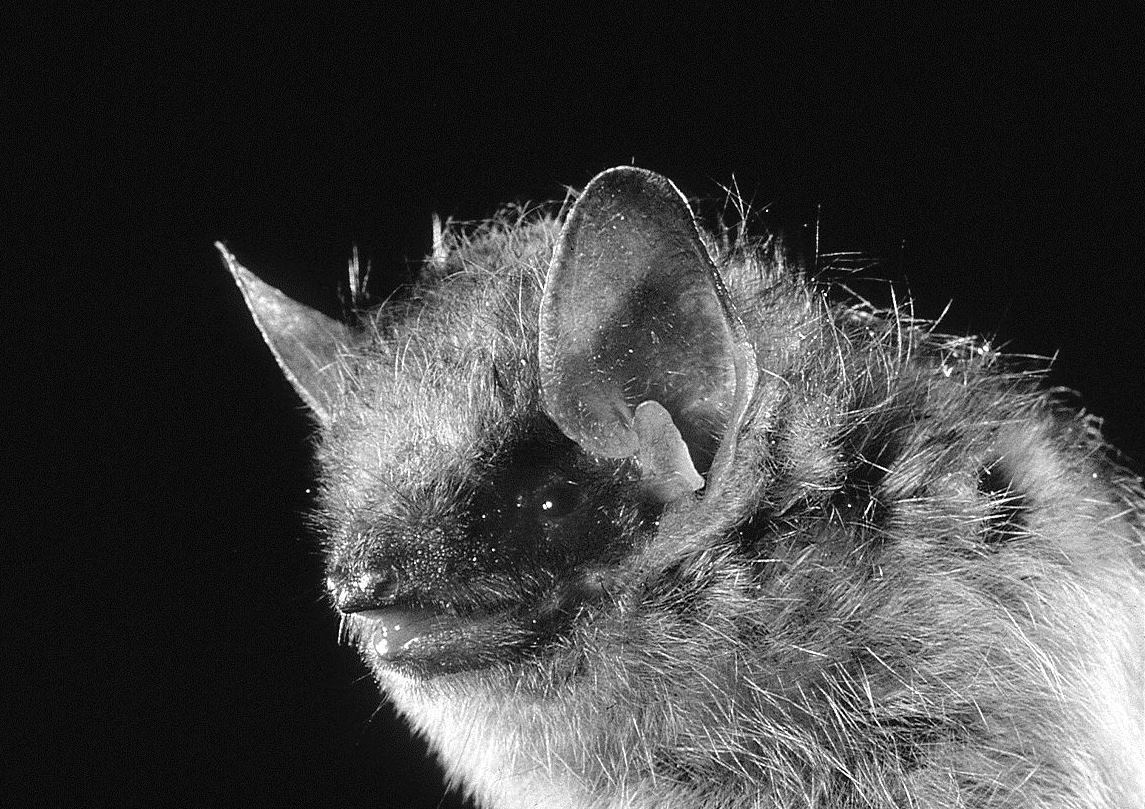AMERICAN PERIMYOTIS
Perimyotis subflavus (F. Cuvier 1832)
Order Chiroptera : Family Vespertilionidae
DESCRIPTION. A small bat with leading edge of wing and the edges of the membrane between the hind legs much paler than rest of membranes; tragus long and slender; upperparts pale yellowish brown, with grizzled effect; the individual hairs tricolored, dark basally, grayish yellow medially, and dusky at tips. Dental formula: I 2/3, C 1/1, Pm 2/2, M 3/3 × 2 = 34. Averages for external measurements: total length, 85 mm; tail, 41 mm; foot, 8 mm; ear, 14 mm; forearm, 35 mm. Weight, 4–6 g.

DISTRIBUTION. The American perimyotis has been documented from all of the vegetative regions of Texas except for the far western portions of the Trans-Pecos. It is most common in the eastern half and central part of the state. Recent records from Lubbock, Brewster, and Presidio counties suggest a northward and westward expansion of its range in Texas.

SUBSPECIES. Perimyotis s. subflavus over much of the range of the species in the state and P. s. clarus in the extreme southwest in Val Verde County.
HABITS. These small bats are some of the earliest to emerge in the evening from their daytime retreats in caves, crevices in cliffs, mine tunnels, buildings, and other human structures offering concealment. They are relatively slow and erratic in flight and often flutter and flit along watercourses or over pastures and woodlands like large moths. They appear to favor watercourses as foraging grounds. They are much more closely associated with woodlands than is the American parastrelle.
This species is known to spend the winter hibernating in suitable caves within its summer range. Its hibernation is more complete than that of most other North American bats, and they generally roost singly or in small groups. Individuals may hang in one spot for weeks on end, and their torpor is so deep that they are not easily disturbed. They emerge from hibernation early in the spring and remain active well into the fall.
Little is known of their food habits in Texas. In Indiana, they are known to eat small leafhoppers, ground beetles, flies, moths, and ants. Insects are caught in considerable quantities in a short period, and within 20 minutes the bats are gorged. They probably feed at intervals throughout the night and hang up to digest their meals between feeding times.
Mating takes place in the fall. They have been observed copulating as late as November, but males and females have been observed roosting together as early as August. During the period from March to August, adult males and females usually occupy separate roosts. Data suggest that the sperm may remain viable in the vaginal tract of the female until spring, when ovulation occurs (in March or April) and fertilization of the ova takes place; however, copulation in the spring also has been observed. Following a gestation period of about 60 days, twin pups are born, usually during June. The young grow rapidly and are able to fly at 2–3 weeks of age. They are weaned at about 4 weeks.
POPULATION STATUS. Common, year-round resident. The American perimyotis is one of the most common bats in the eastern part of Texas and appears to be expanding its range westward.
CONSERVATION STATUS. The IUCN status of the American perimyotis is least concern, and it does not appear on the federal or state lists of concerned species. At the present time populations are widespread and appear to be stable in Texas, and there are no reasons for concern about its status. In the eastern United States, there has been some concern over potential declines in populations due to fatalities caused by wind turbines.
From The Mammals of Texas, Seventh Edition by David J. Schmidly and Robert D. Bradley, copyright © 1994, 2004, 2016. Courtesy of the University of Texas Press.
Natural Science Research Laboratory
-
Address
Museum of Texas Tech University, 3301 4th street, Lubbock, TX 79409 -
Phone
806.742.2486 -
Email
nsrl.museum@ttu.edu

